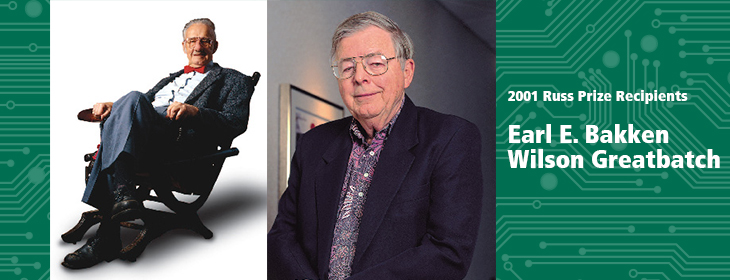2001 Russ Prize
Earl E. Bakken co-founded Medtronic, Inc., one of the world's leading developers and manufacturers of therapeutic medical devices. At Medtronic, he developed the first wearable, external, battery-powered, transistorized pacemaker in 1957. Now retired, Bakken heads the board of directors of the North Hawaii Community Hospital and its developing healing center.
Wilson Greatbatch developed the implantable pacemaker in the late 1950s. After licensing his pacemaker to Medtronic, Inc., it gained quick clinical acceptance in the medical world. He continued to refine and improve his invention through the early 1970s. Since 1985, he has turned his attention to genetic engineering as the founder of Greatbatch Gen-Aid.
The pacemaker is an implantable medical device that is most often used for relieving the symptoms of bradycardia, a type of heart condition in which the heart beats at fewer than 60 beats per minute, a rate that may not fit the body's demands. The pacemaker restores the heartbeat to a normal rate by stimulating the heart muscle with precisely timed discharges of electricity.
In 1949, Bakken co-founded Medtronic, one of the world's leading developers and manufacturers of therapeutic medical devices, as a partnership with the late Palmer J. Hermundslie. Bakken was Medtronic's chief executive officer and chairman of the board from the company's incorporation in 1957 until 1976. He was senior chairman of the board until his retirement as an officer of Medtronic in April 1989.
Born in 1924 in Minneapolis, Bakken served in the U.S. Air Force as a radar maintenance instructor until 1946 when he enrolled at the University of Minnesota. After earning a Bachelor of Science in Electrical Engineering in 1948, he studied electrical engineering with a minor in mathematics at the University of Minnesota Graduate School.
Bakken developed the first wearable, external, battery-powered, transistorized pacemaker in 1957 for C. Walton Lillehei, a University of Minnesota heart surgeon.
Bakken shares the National Academy of Engineering's 2001 Fritz J. and Dolores H. Russ Prize with Wilson Greatbatch.
Born in 1919 in Buffalo, N.Y., Greatbatch attended Cornell University, earning his Bachelor of Science in Electrical Engineering in 1957. He earned his master's in electrical engineering from University of Buffalo in 1957.
Greatbatch's research efforts in biomedical engineering began after graduating from Cornell where he worked for a year at the Animal Behavior Farm. He developed instrumentation for recording cardiovascular and respiratory parameters on experimental animals for Pavlovian studies.
From 1952-1953, Greatbatch served as an associate engineer with the Cornell Aeronautical Laboratory, Buffalo, N.Y. There he assisted in the development and flight testing of an airborne computer for calculating dynamic flight line parameters from Prandtl tube pressure inputs. He was responsible for the design and engineering of the laboratory's first transistorized device: a helicopter airspeed computer.
Greatbatch served the University of Buffalo as an assistant professor of electrical engineering from 1953 to 1957. He also associated himself with the University's Chronic Disease Research Institution investigating the analysis of high-frequency heart-sound components. In 1957, Greatbatch left the University of Buffalo to become a division manager at Taber Instrument Corporation, in North Tonawanda, N.Y.
In the late 1950s, Greatbatch began developing the conceptual framework for an implantable pacemaker. In early 1958, he approached William Chardack, then chief of surgery at the Veteran's Administration Hospital, Buffalo. In his wood-heated barn workshop from 1958 to 1960, Greatbatch hand-built 50 pacemakers, 10 of which were implanted into humans. He used his own savings to build the devices. Wanting to dedicate all of his energies to the development of the pacemaker, he left Taber and founded Wilson Greatbatch, Inc., in 1960.
His pacemaker was licensed to Medtronic, Inc. and achieved quick clinical acceptance in the medical world. He continued to improve and refine the pacemaker's power source, adding in 1970 through 1972, a battery with a lithium anode, an iodide cathode, and a solid-state, self-healing crystalline electrolyte.
In 1963, Mennen-Greatbatch Electronics, Inc., was formed and purchased the physical assets of Wilson Greatbatch, Inc. The patents were subsequently sold to Medtronic and the corporation dissolved. Greatbatch developed Wilson Greatbatch, Ltd. in 1964, an international corporation established to sell medical electronic equipment in Eastern European countries. To provide genetic engineering assistance to medicine and agriculture, Greatbatch formed, in 1985, Greatbatch Gen-Aid, Ltd. Since 1985, Greatbatch has turned his attention to genetic engineering, trying to block the replication of the HIV virus.
